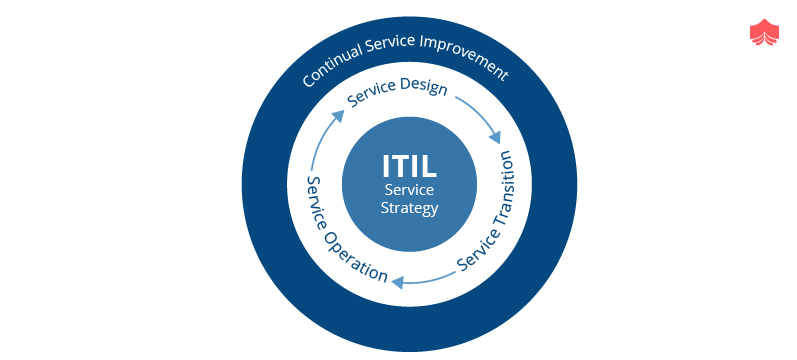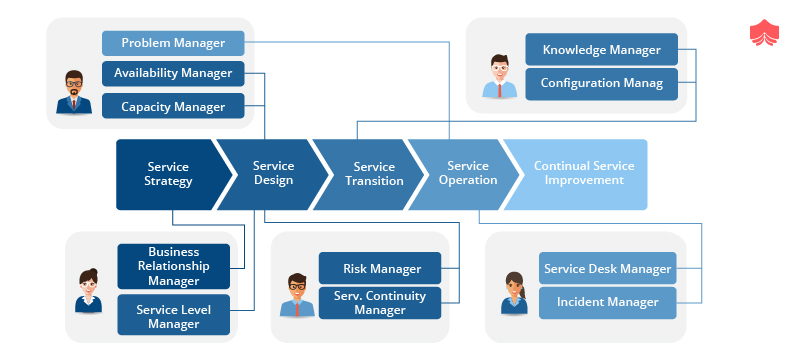Lack of standardised practices in the IT sector created a discordant environment for services, as their efficiency was considerably low and error rates were high as compared to current standards. These irregularities prompted the UK government to envision a set of guidelines for every IT Service organisation to follow. These guidelines, it was hoped, would help not only government organisations but private ones as well.
Therefore, in the 1980s, the UK government, in a bid to increase efficiency and standardise IT processes, created a framework with libraries from around the globe. These multiple libraries were concentrated into seven volumes in ITIL® V2 and eventually five volumes in ITIL® V3. Each volume/certification focuses on a specific part of ITSM.
ITIL® V3 focuses on business needs and calibrates the services according to them. Its other main purpose is also to continuously improve the services while reducing the costs at the same time. Due to ITIL® V3’s ability to smoothly combine business expertise with IT processes, which maximises customer satisfaction, it is adding value to millions of people and businesses around the world.
Its principal purpose is to enable IT professionals to be business service partners as well. It aims to, therefore, combine the business aspect of ITSM – by catering to business and customer requirements – with the professional expertise of the IT industry.
Brought to the public arena in 2007, ITIL® V3 was upgraded and relaunched in 2011 by AXELOS – in collaboration with Her Majesty’s Cabinet Office and Capita PLC as 2011 ITIL® V3. This version included strategic elements which aligned the modern ITSM processes to current business needs.
There are three major ITIL® V3 Fundamentals which we will discuss now.

ITIL® V3 contains five sections as part of the IT service lifecycle, and each section includes multiple processes. ITIL® offers flexibility to an organisation in the form of freedom to adopt any or all of the processes from a particular section. ITIL® is a collection of e-books. Its examinations were earlier administered by EXIN and ISEB, both of which are independent bodies. Both of these bodies gave their certification according to your location.
The two independent bodies formed an alliance during late 2006 to further ITSM. Currently, all exams and certificates are being administered by Accredited Training Organisations (ATOs). These accreditations are themselves administered by Strategic Examination Institutes. These, in turn, need to be accredited directly by AXELOS which enables them to offer certification to the ATOs.

ITIL® powers a well-run IT organisation that not only works efficiently but also keeps optimising the services regularly to provide greater customer experience. Some of the key benefits of implementing ITIL® in an IT organisation as well as businesses are as follows:
Some of the examples of accessible services and applications designed with ITIL® and ITSM are:
Giants like Disney and Sony are prime examples of how one can manage services within a big organisation. Learners can easily take up these case studies to understand the ground situation in the industry. All in all, ITIL® provides a streamlined framework which helps in managing risks, reducing costs while monitoring day to day activities, and finally improvising the course through learning.
The ITIL® Framework has five sections which have evolved over time to reflect the needs of the business and the IT environment. Briefly, this evolution can be described as under:
ITIL® V3, hence, comprises of five sections which cover all aspects of ITSM. These sections further include multiple processes which the organisations implement according to their needs.

These five sections cover the lifecycle of service in ITSM. We will discuss each section one by one to get a clear understanding of what each section contributes towards the lifecycle.
Roles in this space, of ITIL® and ITSM, can be elaborated as under:


ITIL® V3 has a credit system which awards recognition through certificate-based examination. There are multiple certifications and with each one, you accumulate credits.
You can enhance your reputation in the IT industry by rising through the ranks of ITIL® certifications which is awarded on a credit-basis exam. Credits are required to be eligible for higher certifications.
The ITIL® V4 modules vary slightly from the ITIL® V3 structure and will be released during 2019, with Foundation being made available in February 2019. Modules, including the ITIL® Specialist module, the ITIL® Strategist and the ITIL® Leader will be released in the latter half of 2019.
Post the ITIL® V4 Foundation level; the candidate can choose to pursue either the ITIL® Managing Professional (ITIL® MP) or ITIL® Strategic Leader (ITIL® SL). End-learners must complete both – the ITIL® MP and ITIL® SL – to be eligible to certify as an ITIL® Master.
To be certified as an ITIL® Managing Professional, the candidate must complete the following modules:
To be certified as an ITIL® SL, candidates must complete the following modules:
The ITIL® Strategist: Direct, Plan & Improve is a universal module for both the ITIL® streams. This is followed by the MALC i.e. Managing Across The Lifecycle, ITIL® Expert and then the ITIL® Master, all of which are advanced levels to ensure the candidate attains the ITIL® certification.
Some important pointers of ITIL® V4 are as under:
It is important to note that the ITIL® system uses a credit system right from the Foundation level through the Expert levels with each certification amounting to a certain number of credits. The following chart illustrates the current ITIL® credit system:
As part of the lifecycle of ITIL® V3 services, five sections are defined and each of them plays a key role in the service’s life. These five sections contain multiple processes, which in turn, are adopted by the companies or organisations into their teams.
Starting from the planning, according to the business needs, to the improvement or the eventual retiring of a service, ITIL® V3 covers all stages of ITSM. Due to the coverage it provides, it has become an essential part of ITSM.
It is up to an organisation as to which processes of a section it may want to select and what not. This property of ITIL® makes it flexible for implementation purposes.
The five sections in a lifecycle of an ITIL® V3 service are:
With the introduction of ITIL® V3, AXELOS aimed to focus more on the business needs of the industry, instead of just concentrating all resources on the basic IT operations – which ITIL® V2 did. The ITIL® V2 contained the following disciplines:
We can conclude from the above disciplines that the sole aim of ITIL® V2 was to support basic IT processes. ITIL® V3, on the other hand, extends this support to the whole lifecycle of a service and more importantly, catering to the needs of the business and customers.
Besides these, ITIL® V3 has other major differences and upgrades from ITIL® V2 which we have compiled and shown in the table below:
- Strategy Generation
- Financial Management
- Demand Management
- Service Portfolio Management
- Service Catalog Management
- Service Level Management
- Availability Management
- Capacity Management
- IT Service Continuity Management
- Information Security Management
- Supplier Management
- Transition Planning and Support
- Change Management
- Service Asset and Configuration Management
- Release and Deployment Management
- Service Validation and Testing
- Evaluation
- Knowledge Management
- Event Management
- Incident Management
- Request Fulfillment
- Problem Management
- Access Management
- The 7 improvement process
- Service Measurement
- Service Reporting
Research & References of |A&C Accounting And Tax Services
Source
